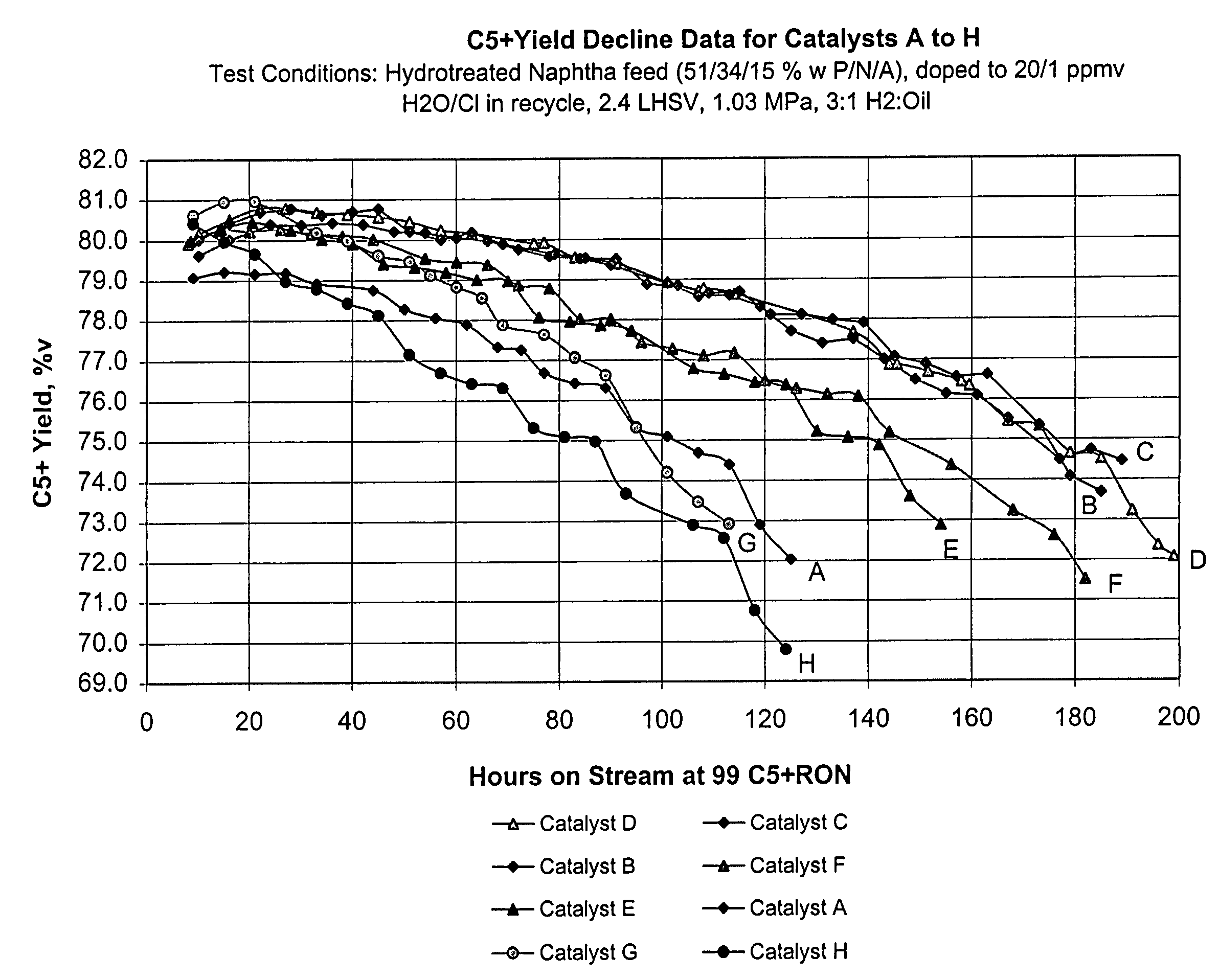Bismuth- and phosphorus-containing reforming catalysts, method of making and naphtha reforming process
a naphtha reforming catalyst and bismuth phosphorus technology, which is applied in the field of bismuthand phosphorus-containing naphtha reforming catalysts, can solve the problems of not teaching the unexpected performance benefits of including both bismuth and phosphorus in a noble metal naphtha reforming catalyst, and achieves the effects of reducing coking rate and c5+ yield, improving octane, and reducing activity
- Summary
- Abstract
- Description
- Claims
- Application Information
AI Technical Summary
Benefits of technology
Problems solved by technology
Method used
Image
Examples
example 1
[0036]This example describes the preparation of five catalyst supports of the present invention, each containing a different concentration of bismuth.
[0037]Support A was prepared by mixing 1 kg of γ-alumina with 627 g of alumina sol in a blender for 10 minutes. With the blender running, 9.1 g of 85 wt. % H3PO4 were slowly added and blending continued for about another minute. Then, the bismuth solution defined in Table 1 for Support A was added to the blender and the blending was continued for another 7 minutes to form an extrudable paste. The paste was extruded into 1.6 mm diameter pellets which were dried at 125° C. overnight. The pellets were then sized to a predominant length of 4 to 6 mm and calcined at 660° C. for 1.5 hours. The finished Support A had the composition shown in Table 1.
[0038]Supports B, C, D and E were prepared in the same manner, except that Solution A was replaced with the solution appropriate for each support as shown in Table 1.
[0039]
TABLE 1SupportABCDESolut...
example 2
Comparative
[0041]This example describes the preparation of three conventional catalyst supports, Support F comprising alumina containing the same concentration of bismuth as Support D of Example 1, i.e., 0.06 wt. %; Support G comprising alumina containing the same concentration of phosphorus as the supports of Example 1, i.e., 0.3 wt. %; and Support H comprising pure alumina.
[0042]Support F was prepared following the procedure described in Example 1 except no H3PO4 was added. Support G was prepared following the procedure described in Example 1 except no Bi / d-mannitol solution was added. Support H was prepared in like manner except neither H3PO4 nor Bi / d-mannitol solution were added.
example 3
[0043]This example describes the preparation of five catalysts of the present invention, each containing a different concentration of bismuth in its support.
[0044]Five impregnating solutions were prepared, each by mixing 0.77 ml of concentrated HNO3, 1.97 ml of concentrated (12M) HCl and 0.660 g of a solution of chloroplatinic acid (denoted as CPA, 29.7 wt. % Pt) and 30 ml of deionized water. The solutions were stirred and another 120 ml of deionized water were added to bring the total volume of each of the impregnating solutions to 150 ml. The solutions were then placed in a 500 ml. graduated cylinder and circulated with the aid of a peristaltic pump. In addition, CO2 gas was bubbled at a very low rate through a gas dispersion tube placed in the bottom of the graduated cylinder and into the solution. This was done in order to provide HCO3− anions which are known to those skilled in the art as capable of competing with Pt and Re anions for alumina surface and to provide for better d...
PUM
| Property | Measurement | Unit |
|---|---|---|
| pressure | aaaaa | aaaaa |
| temperature | aaaaa | aaaaa |
| temperature | aaaaa | aaaaa |
Abstract
Description
Claims
Application Information
 Login to View More
Login to View More - R&D
- Intellectual Property
- Life Sciences
- Materials
- Tech Scout
- Unparalleled Data Quality
- Higher Quality Content
- 60% Fewer Hallucinations
Browse by: Latest US Patents, China's latest patents, Technical Efficacy Thesaurus, Application Domain, Technology Topic, Popular Technical Reports.
© 2025 PatSnap. All rights reserved.Legal|Privacy policy|Modern Slavery Act Transparency Statement|Sitemap|About US| Contact US: help@patsnap.com



